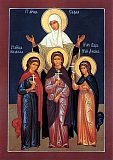

| Previous day | Next day |
| Old Style
September 17
|
Monday |
New Style
September 30
|
| 16th Week after Pentecost. Tone 6. | No fast.
|
![]() Martyrs Sophia and her three daughters, Faith (Vera), Hope (Nadezhda), and Love (Lyubov), at Rome (ca. 137).
Martyrs Sophia and her three daughters, Faith (Vera), Hope (Nadezhda), and Love (Lyubov), at Rome (ca. 137).
Martyr Theodota, at Nicaea (230). Martyr Agathoclia (230). 156 Martyrs of Palestine, including Peleus and Nilus, bishops, Zeno, priest, and Patermuthius and Elias, noblemen (310). St. Joachim I, patriarch of Alexandria (1567). St. Innocent, archimandrite, of Glinsk Hermitage (1888).
New Hieromartyrs Paul (Moiseyev) and Theodosius (Sobolev), archimandrites, and Nicodemus (Shchapkov) and Seraphim (Kulakov), hieromonks, of the St. Nicholas Koryazha Monastery (Arkhangelsk) (1918).
Hieromartyrs Heraclides and Myron, bishops of Cyprus (1st c.). Martyrs Lucy and her son Geminian, of Rome (303). Hieromartyr Lambert, bishop of Maastricht (704). St. Anastasius of Perioteron on Cyprus (12th c.). St. Eusipius of Cyprus.
Repose of Blessed Agapitus (1825), disciple of St. Tikhon of Zadonsk, and lay recluse Matthew of St. Petersburg (1904).
Thoughts for Each Day of the Year
According to the Daily Church Readings from the Word of God
By St. Theophan the Recluse

Monday. [Gal. 4:28-5:10; Mark 6:54-7:8]
The Lord rebukes the Pharisees not for their external routines and rules of conduct, but for partiality toward them—for limiting themselves to external worship of God, with no concern for what was in the heart. It is impossible to be without externals. The highest internal things require the external as their expression and garment. In reality, internal things are never alone, but are always united with the outer; only in false theories are they separated. But again it is obvious that externals alone are nothing; their worth comes from the presence of the internal things contained in them. Thus, once the internal ceases to be, the external might as well not be there. Meanwhile, we have a weakness for outward appearances in which the internal is depicted and takes definite form, to such an extent that we are satisfied with fulfilling them alone, without even thinking that there might be internal things. And since the internal is harder to attain than the external, it is quite natural to get stuck on the latter, not striving for the former. What can we do? We must govern ourselves and keep the internal things in mind, always pushing ourselves toward them through the externals, only considering a work to be real when the internal and external are united in it. There is no other way. Attentiveness toward oneself, soberness, and vigilance are the only levers for raising up our nature which is fat and has a penchant for lowly things. Notice that those who possess the internal never abandon the external, though they consider it to be of no particular value.
Monday. [Eph. 4:25-32; Luke 3:19-22]
Herod is an image of self-love, irritated by his troubled conscience, reproached by the truth; self-love seeks to escape this unpleasantness by applying force. John the Forerunner is an image of the truth persecuted by another’s self-love, when this self-love is able to do so. No matter how one softens the truth with all the soft words and turns of speech that tender love can invent, not desiring to injure or wound another’s heart, the face of truth will nevertheless appear before the eyes of the conscience, and stir up a tempest of denunciation within. Selfishness is near-sighted, it cannot see that the denunciation is not coming from without but from within, and it rises up with all of its strength against the external accuser. By blocking his lips, this selfishness expects to silence the inner voice as well. It does not succeed, however; it does not direct its concern in the right direction. One must pacify the conscience; then, no matter how many external accusers there will be, they will not disturb the inner world, but on the contrary only deepen it, compelling one to gather calming convictions within—faith in the crucified Lord, sincerity of repentance and confession, and firmness in the resolution to do nothing against one’s conscience. This is where one must look, and not keep putting all Johns into prison; for the word of God’s truth walks everywhere upon the earth, and each one is an accusing John to you.

